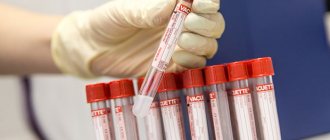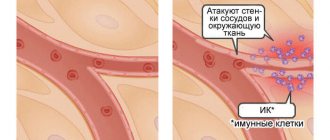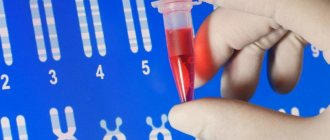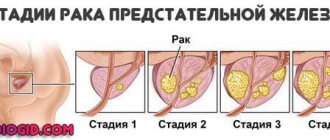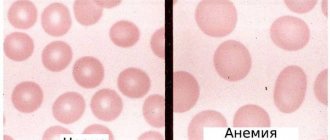Blood provides metabolism, nutrition and even respiration for all cells and tissues in the body. Doctors always closely monitor its indicators, using tests to determine the presence of certain diseases that destroy the body from the inside without visible symptoms. That is why blood tests are regularly taken: both for preventive purposes and to make a more accurate diagnosis.
One of the most important components of blood are red blood cells or, as they are also called, red cells. They have a disc-shaped, doubly concave shape and perform one of the most important functions in the body - transporting oxygen to cells and carbon dioxide for its removal. Their size is not as important as their volume. In a healthy person, the volume of all red blood cells should be approximately the same, or with slight deviations from the norm; in the case of pathology, different cells appear. To identify such abnormalities, a blood test for RDW is performed.
The abbreviation RDW stands for Red Cells Indicies and translated means “red blood cell distribution width.” This indicator can be found in the results of a general blood test, since a separate study of red blood cells is not carried out. It has two markers:
- RDW-CV: shows how much cell size differs from the average (measured as a percentage)
- RDW-SD: Reflects the difference in size between the smallest and largest red blood cells (measured in femtoliters).
Indications for testing
Often, such an analysis is preventive and is taken on a regular basis (on average once a year) to identify diseases in the early stages, when they are much faster and easier to treat. It is prescribed to pregnant women to monitor their general condition and identify problems such as anemia, and for inpatient monitoring.
A general blood test is required during hospitalization to conduct a basic examination and obtain a more accurate picture of the disease, as well as before surgery to prevent possible complications. If the body is severely weakened, this may indicate that the person will not survive the operation; in such cases, it is necessary to undergo preliminary treatment for recovery.
The analysis is prescribed to identify and diagnose different types of anemia, as well as for possible diseases of the hematopoietic system. A general blood test helps track dynamics during monitoring of ongoing treatment, accurately determining the onset of improvements or deteriorations in the body’s condition, which helps to timely adjust treatment. It can be prescribed by a physician, general practitioner, surgeon, neurologist and hematologist.
Why does the size of red blood cells change?
If RDW is elevated in a blood test, what does this mean? This is a common question. The simplest source of the problem of changes in blood cells is considered to be an unbalanced human diet. With a non-critical transformation of blood quality, the issue most likely lies in the deficiency of certain microelements, mainly such as B9, A, B12, folic acid, iron. If the reason lies in poor nutrition, then it is often enough to simply change the situation by adjusting it, that is, eating foods that contain the necessary nutrients in sufficient quantities.
If this indicator significantly exceeds the norm, then the person has reason to worry and immediately consult a doctor for a thorough examination.
Blood levels
As mentioned above, the RDW indicator has two markers: RDW-CV and RDW-SD, each of which has its own units of measurement and content standards. Next we will look at each of them.
RDW-CV reflects the deviation of red blood cell size from the average, measured as a percentage and has different standards depending on the person’s age.
- Children under 6 months: from 14.9 to 18.7%
- Children over 6 months: from 11.6 to 14.8%
- Adults: 11.5 – 14.5%
RDW-SD shows deviations in the distribution of red blood cells by volume and is measured in femtoliters. The standard deviation is 37 – 54 femtoliters, regardless of age or gender.
More significant reasons
Even more significant reasons for changes in erythrocyte volume are:
- drinking untreated, low-quality or chlorinated water;
- defects in the functioning of the respiratory system or heart and blood vessels;
- period of growing up or approaching old age;
- genetic predisposition;
- the occurrence of iron deficiency anemia;
- various complications after ARVI, flu or colds;
- chronic infections;
- manifestation of symptoms of certain diseases (oncology, malignant tumors, etc.).
Deviations from the norm (what they talk about)
Before talking about the possible reasons for deviations in this indicator, it is worth noting that it is not specific and cannot serve to accurately determine a particular disease. RDW is analyzed only in conjunction with other data from a general and biochemical blood test. So, if there is a slight deviation from the norm, but other indicators do not cause concern, then, most likely, this simply indicates the characteristics of the body, but to make a more accurate diagnosis, you need to consult a doctor.
An increase in RDW is normal only for newborns under 6 months of age. There is also a slight increase as a result of recent nervous stress and after a blood transfusion, but in all other cases, elevated results indicate the presence of the disease. They may indicate various types of anemia:
- Anemia of megaloblastic, myelodysplastic and siderablastic types
- Anemia with heterogeneity in red blood cell size (most often due to diet)
- Anemia due to impaired myelopoiesis
- Anemia due to chronic diseases
- Anemia due to acute blood loss (may indicate internal bleeding)
- Aplastic anemia
Also, elevated RDW levels may indicate the following diseases:
- Some homozygous hemoglobinopathies and homozygous thalassemias
- Increased reticulocyte count
- Hyperglycemia
- Congenital genetic diseases
Reduced indicators do not indicate the presence of any abnormality or disease, therefore such values are not taken into account during the examination. Most likely, this is a variant of the norm.
Blood functions
Blood is the most important indicator, by the parameters of which you can assess the condition of the body. It is a liquid medium containing plasma and formed elements: platelets, erythrocytes and leukocytes.
blood cells are red cells whose shape resembles a concave disc. These are cells without nuclei. Their size varies from 7.5 to 8.3 microns, and they live from 3 to 4 months. Red blood cells have antigenic properties, on the basis of which there are 4 blood groups.
In addition to mature red blood cells, young blood cells can be found in the blood. Such cells do not have nuclei and contain large amounts of RNA and ribosomes. They have membrane receptors for transferrin. Reticulocytes lose RNA and the ability to produce hemoglobin when they become a mature cell.
The circulatory system in the body is very important. Since such an environment provides nutrition to organs and tissues, a general blood test is required constantly. During the study, the color, size and shape of blood cells are taken into account. Changes in shape and size indicate poikilocytosis and anisocytosis occurring in the body.
How the research works
In modern medicine, equipment plays an important role in treatment. the same can be said about a blood test. On an empty stomach, blood is drawn either from a vein in the elbow or from a finger (this method is especially often practiced in the case of children), and then all the work is transferred to a modern analyzer, which conducts research quickly and with high quality, giving an accurate result .
It counts the number of red blood cells of different sizes per microliter of blood, calculates the average cell size and determines the degree of deviation from the norm of this indicator. The largest and smallest cells are also measured and the difference between this spread and the possible norm is analyzed. This indicator is recorded in femtoliters.
Of course, the equipment may not always be accurate; maximum accuracy of results can only be obtained by manual counting, but this is a very long and labor-intensive process, which is practically not used in modern medicine.
If deviations in this indicator occur, the blood test is performed again to obtain a reliable result, because the diagnosis cannot be made as a result of a single blood sample.
References
- Nazarenko, G.I., Kishkun, A.A. Clinical evaluation of laboratory results. - M.: Medicine, 2006. - 544 p.
- Tatkov, O.V., Stupin, F.P. General blood analysis. Information collection. - M.: Publishing solutions, 2021. - 72 p.
- Fauci, A., Braunwald, E., Kasper, D. et al. Harrison's principles of internal medicine, 17th edition, 2009.
- Pagana, K., Pagana, T., Pagana, Th. Mosby's Diagnostic and Laboratory Test Reference. 14th Edition. Elsevier Publishing Hall, 2019. - 1094 p.
Preparation for the procedure
Since taking blood for a general analysis does not imply anything unusual, and the study itself is carried out regularly for almost all people, preparation does not require a person to take any special measures, but no one has canceled the standard recommendations before taking tests so that the results are reliable and correctly reflect the clinical picture:
- The RDW test is taken in the morning and on an empty stomach. Dinner in the evening of the previous day before donating blood should be light and at least 8 hours should pass between the last meal and the test, and preferably 12
- It is highly not recommended to drink alcohol 2 days before the test, as it can significantly distort the results
- It is advisable to give up fatty and fried foods, which have a negative effect on the body, 2 days in advance.
- You should not take a blood test after physiological and x-ray procedures
- It is recommended to refrain from smoking one hour before blood collection.
- It is advisable to exclude any physical and emotional stress; before the analysis, a 15-minute break and complete calm are required.
- Particular attention must be paid to the medications you are taking. Almost any medicine can distort the results of a blood test, so before donating blood you need to consult with a specialist: you may have to stop taking the medicine for a while to get an accurate clinical picture, or simply take the drug after the test.
If a repeat blood test is prescribed, it must be taken at the same time (since the composition of the blood may depend on the body’s circadian rhythms) and in the same laboratory. This is due to the fact that units and methods of measurement may vary between laboratories. Only if all recommended measures are followed will the result of the study be correct.
To improve your appearance
Support for Turbo pages on a wider class of mobile screens - so that your Turbo pages look equally good not only on mobile, but also on tablets.
Transferring html layout directly to RSS. To make it more convenient for you to work with the appearance of Turbo pages, we will add the ability to transfer your own html layout directly to RSS. It will be possible to transfer ready-made blocks of your website to the Turbo page practically without changes and not waste time re-configuring the appearance.
Settings for basic design elements without CSS. And so that you can save time on developing your own CSS, let's add the following features:
- customize color, font, logo and other elements directly in Webmaster,
- quickly enable light and dark themes on your website.
Analysis for RDW in MedArt
The medical laboratory is equipped with modern high-precision equipment, high-quality reagents, all necessary consumables and qualified personnel. Our clients can rest assured of the reliability: if all preparation recommendations are followed, the results obtained will be 100% accurate. rdw in the blood test is reduced
Our team performs the work quickly, efficiently and with due understanding. Since there are people who are catastrophically afraid of any medical intervention, including blood sampling, we try to provide all our clients with the most comfortable and calm atmosphere, while performing all hematological studies at the highest level and providing accurate results.
With us, you can take a general blood test in a calm and comfortable environment and get a reliable result in the shortest possible time at an affordable price, without waiting in line for long hours, and then endlessly visiting doctors in an attempt to find out the result. We care about each of our clients and strive to do our work with the highest quality possible.
Raising RDW
The RDW level can be elevated in some situations. The most common cause of this pathology is iron deficiency anemia. The indicator can change at different stages of pathology development, which is clearly reflected in the histogram of red blood cells:
- The initial stage of anemia development is characterized by normal indices, but hemoglobin will be greatly reduced. This is the result of healthy functioning of the spinal cord.
- The next stage of development in the histogram will show an increase in RDW. When there are problems with hemoglobin, indicators such as the average concentration and content of hemoglobin in a blood cell and the average volume of red cells decrease.
When treating IDA, it is necessary to normalize the level of concentration of iron-containing protein and its characteristics in the human blood.
Signs
In the event that deviations in the activity of the circulatory system become more than minor changes, the human body gives certain alarm signals.
In any case, adjusting your diet or starting to treat the pathological process at an early stage is easier than bringing the matter to a critical stage.
The following symptoms may indicate an increase in RDW in the body:
- a strong increase in temperature of a systematic nature;
- excessive sweating;
- decreased activity, general fatigue, drowsiness;
- sudden changes in mood for no apparent reason;
- in some cases, the skin acquires a yellow tint.
If the symptoms listed above are noted, then there is no need to self-medicate or think that everything will go away on its own. It’s not worth much effort to see a doctor and get tested at the nearest laboratory or clinic. It is impossible to allow the occurrence of such consequences that can manifest themselves with the development of anisocytosis to the second, third and fourth degrees.
It is very important to understand the significance of a general blood test. RDW is often elevated, but only a qualified specialist is able to make the correct diagnosis based on the information received. In this case, it will also help to add possible additional signs that may worry the patient. Naturally, it is much easier to prevent a disease or eliminate it at an early stage.

